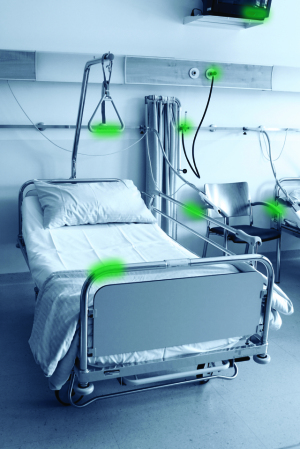Bioburden: Fighting Hospital Acquired Infections
by Kathy Mahdoubi, Senior Correspondent | September 25, 2009

Touch surfaces are
prime territory for
the spread of bacteria.
prime territory for
the spread of bacteria.
This report originally appeared in the August 2009 issue of DOTmed Business News
Hospitals are meant to be places we go to get well, but some are becoming places where just the opposite occurs. There has been the fear of "super-bugs" for many years, and based on emerging reports, that fear may be becoming a reality. Microorganisms are evolving into stronger, more resilient pathogens that can withstand the health care industry's full arsenal of antibiotics. As a result, hospitals run the risk of acting as a distribution center for the transmission of infectious diseases.
According to the Centers for Disease Control and Prevention, an estimated two-million Americans contract hospital-acquired infections and more than 90,000 patients die due to complications from infection, costing the health care system up to $6.5 billion each year.

 As pathogens become stronger and new strains evolve, hospitals have had to step-up protocol to prevent infection among patient populations. Also on the rise is the implementation of advanced technologies that test for the presence of microorganisms on surfaces, systems that can provide broad-spectrum decontamination of whole hospital wards and health information technology designed to track and analyze infection data in hospitals across the country.
As pathogens become stronger and new strains evolve, hospitals have had to step-up protocol to prevent infection among patient populations. Also on the rise is the implementation of advanced technologies that test for the presence of microorganisms on surfaces, systems that can provide broad-spectrum decontamination of whole hospital wards and health information technology designed to track and analyze infection data in hospitals across the country.
Getting to Know the Culprits
Infectious disease experts and infection control professionals, or preventionists, cringe at monikers like "super bug." Dr. Mark Rupp, president of the Society for Healthcare Epidemiology of America (SHEA), and Stephen Streed, a member of the board of the Association for Professionals in Infection Control (APIC), prefer to keep to the science and steer clear of the generalities. Alongside the CDC, SHEA and APIC are leading organizations in the fight against health-care acquired infections and each offers resources and a wealth of knowledge about the pathogens wreaking havoc in hospitals today.
Three very common multi-drug resistant organisms have made American hospitals their own private Petri dish: Methicillin-resistant Staphylococcus aureus (MRSA), Vancomycin-resistant Enterococcus (VRE) and Clostridium difficile (C. diff).
"What a lot of people don't fully appreciate is that Staph aureus is an organism that is in many respects part of our natural flora," says Dr. Rupp, who is also a professor of infectious disease and the medical director of Nebraska Medical Center Department of Healthcare Epidemiology, Omaha. "If we go out on the street and culture everybody that we meet we will end up finding that somewhere around a quarter to a third will be colonized with Staph aureus. If we take that same population of people and culture them repetitively over the course of several months or a year we will find that nearly everybody has Staph aureus that they carry on their skin or mucus membranes at one time or another."
Hospitals are meant to be places we go to get well, but some are becoming places where just the opposite occurs. There has been the fear of "super-bugs" for many years, and based on emerging reports, that fear may be becoming a reality. Microorganisms are evolving into stronger, more resilient pathogens that can withstand the health care industry's full arsenal of antibiotics. As a result, hospitals run the risk of acting as a distribution center for the transmission of infectious diseases.
According to the Centers for Disease Control and Prevention, an estimated two-million Americans contract hospital-acquired infections and more than 90,000 patients die due to complications from infection, costing the health care system up to $6.5 billion each year.
New Fully Configured 80-slice CT in 2 weeks with Software Upgrades for Life
For those who need to move fast and expand clinical capabilities -- and would love new equipment -- the uCT 550 Advance offers a new fully configured 80-slice CT in up to 2 weeks with routine maintenance and parts and Software Upgrades for Life™ included.

Getting to Know the Culprits
Infectious disease experts and infection control professionals, or preventionists, cringe at monikers like "super bug." Dr. Mark Rupp, president of the Society for Healthcare Epidemiology of America (SHEA), and Stephen Streed, a member of the board of the Association for Professionals in Infection Control (APIC), prefer to keep to the science and steer clear of the generalities. Alongside the CDC, SHEA and APIC are leading organizations in the fight against health-care acquired infections and each offers resources and a wealth of knowledge about the pathogens wreaking havoc in hospitals today.
Three very common multi-drug resistant organisms have made American hospitals their own private Petri dish: Methicillin-resistant Staphylococcus aureus (MRSA), Vancomycin-resistant Enterococcus (VRE) and Clostridium difficile (C. diff).
"What a lot of people don't fully appreciate is that Staph aureus is an organism that is in many respects part of our natural flora," says Dr. Rupp, who is also a professor of infectious disease and the medical director of Nebraska Medical Center Department of Healthcare Epidemiology, Omaha. "If we go out on the street and culture everybody that we meet we will end up finding that somewhere around a quarter to a third will be colonized with Staph aureus. If we take that same population of people and culture them repetitively over the course of several months or a year we will find that nearly everybody has Staph aureus that they carry on their skin or mucus membranes at one time or another."










